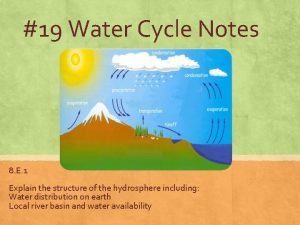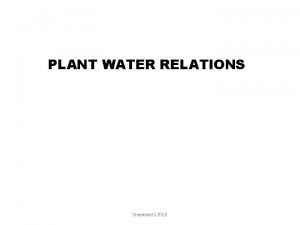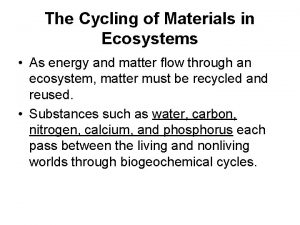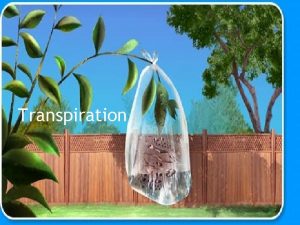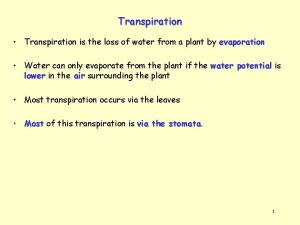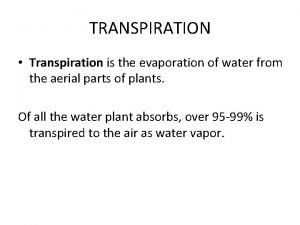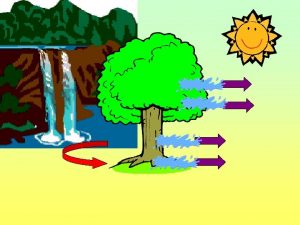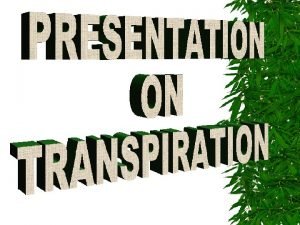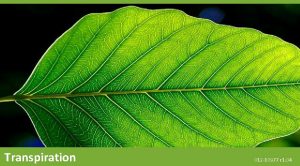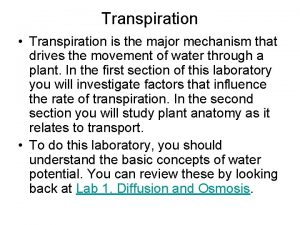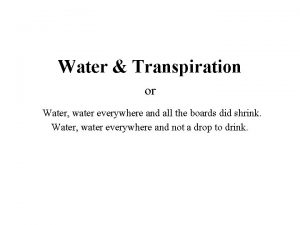Transpiration and water use of an old growth












- Slides: 12

Transpiration and water use of an old growth Mountain ash forest Stephen Wood, Jason Beringer, Lindsay Hutley, David Mc. Guire, Albert Van Dijk, Musa Kilinc

Mountain Ash (Eucalyptus regnans) forests and water • • • Water for Melbourne Obtained from 1570 km 2 of forested catchments Mountain Ash forests responsibly for 80% of stream flow Typically 80 -90 m at maturity Tallest recorded at 114 m Occurs in Victoria and Tasmania Cool, moist sites, 150 to 1100 m altitude, ~1000 mm annual rainfall

Wallaby Creek Catchment • 45 km, north east of Melbourne • 110 m EC tower at oldgrowth site Located on Hume Plateau 685 m elevation • Flat terrain ~2% • Rainfall ~1220 mm

Project objectives 24 year old 80 year old 296 year old • Measure transpiration in three different aged stands • To scale up sap flux to canopy scale to compare with eddy covariance tower • To measure understorey ET in old growth forest using sap flux and tower to investigate contribution on total forest water use

Water Balance • Sap flow measured at each site, including 2 main understorey species of old growth • Olearia agrophylla, Pomaderris aspera • Understorey and overstorey EC

Site Characteristics Site age (years) Variable 24 80 296 understorey Average stems per hectare 897. 5 ± 35. 9 238. 5 ± 9. 54 36. 75 ± 2. 47 278 ± 10. 85 Mean Height (m) 21. 23 ± 3. 31 60. 11 ± 5. 18 80. 44 ± 5. 18 8. 26 ± 1. 31 Mean DBH (cm) 25. 66 ± 3. 18 72. 86 ± 3. 18 154. 7 ± 4. 77 13. 6 ± 1. 59 Minimum DBH (cm) 6. 4 ± 3. 18 42 ± 3. 18 94. 5 ± 4. 77 5. 2 ± 1. 59 Maximum DBH (cm) 70 ± 3. 18 120. 9 ± 3. 18 226 ± 4. 77 26. 2 ± 1. 59 LAI 2. 62 ± 0. 04 2. 09 ± 0. 04 1. 69 ± 0. 07 1. 67 ± 0. 07 Sapwood area 8. 89 ± 0. 51 6. 87 ± 0. 52 2. 25 ± 0. 23 2. 14 ± 0. 21 Sap velocity 9. 05 ± 1. 5 12. 8 ± 1. 1 11. 2 ± 1. 4 5. 04 ± 1. 1

• Kuczera curve • Relationship between mean annual water yield and stand age • shortly after fire there was a rapid decline in catchment yield • water yield was predicted to returned to prefire levels, taking up to 200 years to fully recover Declining ET 24 (Kuczera et al. , 1987) 80 294

• Previous studies argue that sap velocity is constant with age and because sapwood area declines so to does transpiration of the stand. They argue that understorey ET is negligible • Our results have shown a decrease in sap wood area and transpiration of the overstorey trees Sapwood area Water use (mm. day-1) Overstorey tree ET 300 (Haydon et al. , 1996, pp. 351)

Comparison of total ET from EC tower and sap flow • Results contradict past studies that assume understorey ET is negligible • Understorey ET makes up 48% of total summer ET • Consistent with LAI • Negligible understorey transpiration attributed to low VPD • Tower data shows RH around 62% not close to saturation • Little difference in air temp within canopy

Change forest transpiration with stand age • 20 year old site – 3. 32 • 80 year old site – 3. 2 • 296 year old site – Mountain Ash – 1. 52 Understorey – 1. 45 • Annual understorey water use calculated as difference between total ET from tower and Mountain Ash sap flow • Understorey ET was a larger proportion of total presumably because of much higher soil evaporation in summer.

• Kuczera’s curve unique • No immediate increase in yield expected with loss of vegetation • most studies of catchment disturbance show an initial increase in yield • Proceeded by a decline in yields associated with vigorous regrowth • Then a small decline in ET back to pre-disturbance levels (Watson et al. 1999)

Conclusions • Slight decline in ET with forest age • Understorey extremely important in constructing total forest ET • These findings provide additional information that can be used to further interpret and refine the relationships suggested by Kuczera. Acknowledgements This study was funded by the Australian Research Council (DP 0451247). We are grateful to Melbourne Water and Parks Victoria for their support. This research was conducted under permit number 10004207. Thanks to Robert Van Pelt, Stephen Sillett and George Koch for providing data on site and tree characteristics.
 Water and water and water water
Water and water and water water Water cycle and transpiration
Water cycle and transpiration Water potential in transpiration
Water potential in transpiration Transpiration is the evaporation of water from
Transpiration is the evaporation of water from Transpiration moves water from
Transpiration moves water from What is plant growth analysis
What is plant growth analysis Primary growth and secondary growth in plants
Primary growth and secondary growth in plants Primary growth and secondary growth in plants
Primary growth and secondary growth in plants Chapter 35 plant structure growth and development
Chapter 35 plant structure growth and development Once upon a time there was a little man
Once upon a time there was a little man Once upon a time there lived an old man and an old woman
Once upon a time there lived an old man and an old woman Growthchain
Growthchain Geometric vs exponential growth
Geometric vs exponential growth

